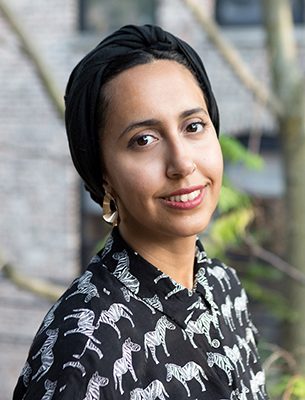In this Featured Member series, AATA celebrates the work of our members. During the coronavirus pandemic, we are inviting members to share their experiences about how their professional and personal lives have changed.
July 2, 2020
What has changed (or remained the same) in your studies during the COVID-19 global crisis?
I currently work at Between Friends Chicago where I offer services to children, youth, adults and families who have survived domestic violence (DV). Since the shelter-in-place order due to COVID-19, many domestic violence cases have increased. Many domestic violence survivors have been highly impacted and crisis calls have increased. My work with DV survivors has always prioritized safety planning, however, since the pandemic started, I am now focusing even more on offering direct services which involves creative safety strategies considering the shelter-in-place order. My understanding of safety planning with DV survivors has shifted since COVID-19. There were new factors to consider for those living with an abusive individual and many new precautions needed to be taken into consideration especially with technology use. As for survivors who had access to a safe environment and were focusing on trauma recovery work, I did acknowledge that the theme of uncertainty was triggering for many and I focused on providing remote art therapy as a way to help clients in resourcing and regulating themselves.
In what ways have your clients been impacted by COVID-19? Have you been able to continue care? How are you managing your own stress related to their experiences?
Luckily we have been able to continue providing our counseling and court advocacy services remotely to our clients. However many programs that I have been involved in planning for at our agency have been held up or I had to alter my approach to executing them. For example I have been planning for a new art therapy group, and some family art therapy evenings, an arts exhibition and an outreach community workshop in collaboration with an art center, and these have all had to shift either by cancellation or moving into the virtual realm. Additionally a portion of my work includes offering domestic and teen-dating violence counseling services with youth in high schools. A lot of that work has been impacted because the safest way youth could get access to these specific counseling services was through attending school. It was quite challenging in the beginning to collaborate with our partnering schools to find a safe system to communicate with our youth survivors and continue offering them resources and services.
Also, children have been the most vulnerable during these times because services for them have changed a lot since we are not seeing them on site anymore. However we still found ways to engage the families in these times and provide caregivers with self-led art workshops to conduct with their children to encourage them to spend intentional time together to maintain the strength of their connection as they pass through these hard times. The theme so far since the pandemic started has been a process of navigating uncertainties and overcoming barriers through communication and collaboration. Which is something that I am holding on to for my own self-care in these uncertain times personally and professionally. I am doing my best to stay connected with my own community and studio art making practice which provide me with some insights, support and serve as a creative resource.
In what ways has your living or work space changed?
I have been working from home since the start of the pandemic and offering remote services to my clients. I had to try to experiment different set-ups to implement my work/life balance and boundaries. Additionally it has been an adjustment with offering remote art therapy services. I have had to work with my team to find creative ways to safely provide clients with art supplies and think on art therapy directives that can be practiced distantly and virtually with minimal disruption to the trauma processing we have been doing, but also considering the impact of what can come up when working with someone in this manner.
How do you view your role as an art therapist or student during COVID-19?
I was amazed and surprised at how adaptive I was able to still make use of art even in a distant manner. When working in-person with clients I put effort into creating a safe container with my clients so that we can build trust that can open them up to exploring new art materials as part of their art therapy services. Creating a virtual container has been a challenge in the beginning, I felt the barrier of the screen and the inability to share materials or demonstrate art techniques in person come between us. However with time, I found that both me and my clients communicated and came up with mutual agreements on setting up ourselves in the most comfortable way possible that we can still find containment within our remote art therapy session. This highlights the importance in holding space for clients to use their voice and agency within the therapeutic alliance, especially for DV survivors.
In my recent art therapy interventions, I have been engaging clients mostly with fiber projects such as embroidery and weaving on small home-made hand looms. I am thinking a lot about materials that can also be accessible for clients when we are outside of our session and they can use it as a resource. I’ve found this approach successful and clients finding movement and development in their woven or embroidered pieces, even in a time when we are all feeling so stuck. Additionally, I have been planning a communal project with one of our groups, where I am inviting our clients to create a collective collaged tapestry together that reflects our connection. Artworks will be made separately by individuals then mailed in, I will stitch them together then share the documentation with our clients. Eventually we will exhibit it in our agency’s group space, serving as a reminder of the times we have overcome through our community’s connections.
Is there anything else you would like to share with the community during these uncertain times?
Just as much as we, art therapists, invite our clients to engage in art for resourcing and support, I have also been holding myself accountable to do the same on my own time. Spending time in my studio and making has assisted me in both maintaining my worry levels in the midst of this global crisis, and continuing to make meaningful connections to the present moment that surrounds me through the insights that the processes of art making provides.

“Temporary Deformations” by Farah Salem. Photography, Fabric, Digital Renderings. April 2020.
Artist Statement: “Since the pandemic started, I have been working in my studio on a series titled Temporary Deformations. I started working with old photographs and found materials around the house to create a series of digital renderings which brings forth fiber glitches embedded within desert rock landscapes. Introducing these glitches implies a moving body that emerges from the cracks of a rigid boundary. It brings agency and movement to the rocks which emulate an illusion of stillness, yet truly they are in constant movement. The movement of formations is dictated within the context of the photograph in relation to the friction generated by moving fiber images, challenging restriction. When viewing the work the definition of bodily motions with distinct expressions is projected on the rocks. Fiber layers enable a seamless disruption of the compressions. The work indicates that the illusion of a state of stability is about to fall before the viewers eyes. The desert landscape elicits unknowns and insecurities; thus we’d rather hallucinate a familiar reality governed by stagnant pre-conditionings veiled in the name of traditions which we have yet to shed. To me, this was a response to many things I was witnessing in our world, but mostly, our confrontation with uncertainty as a result of COVID-19, and how we were seeing old structures crumble and reveal their lack of sustainable foundation. ”
Farah Salem A., MAATC
 I am an artist and art therapist practicing in Chicago. I operate from a cross-cultural understanding, and provide bilingual art therapy and counseling in both English and Arabic. My art therapy counseling practice is centered within an intersectional feminist and social justice lens, a trauma-informed approach, and a relational-cultural framework. I have offered my services in clinical and community-based settings. My clinical experience includes working with individuals of all ages who are domestic and gender-based violence survivors, refugees and immigrants and people recovering from trauma and substance use. As a multidisciplinary studio artist, my practice is rooted in photography and expands into video, performance, fibers, projection, and installation. I attempt to capture the portals and spaces between two or more worlds, as I engage the performing body in movement from cultural to natural landscapes. My artwork explores the politics of seeing and the roles of access, agency and power in the displacement of identity as a material. As I continue to engage in my own studio practice, I see reflections of my research and material exploration bridge into my clinical work. Through our creative material exploration, participants can externalize inner experiences and create tangible, visual evidence of the changes they want to make in their lives.
I am an artist and art therapist practicing in Chicago. I operate from a cross-cultural understanding, and provide bilingual art therapy and counseling in both English and Arabic. My art therapy counseling practice is centered within an intersectional feminist and social justice lens, a trauma-informed approach, and a relational-cultural framework. I have offered my services in clinical and community-based settings. My clinical experience includes working with individuals of all ages who are domestic and gender-based violence survivors, refugees and immigrants and people recovering from trauma and substance use. As a multidisciplinary studio artist, my practice is rooted in photography and expands into video, performance, fibers, projection, and installation. I attempt to capture the portals and spaces between two or more worlds, as I engage the performing body in movement from cultural to natural landscapes. My artwork explores the politics of seeing and the roles of access, agency and power in the displacement of identity as a material. As I continue to engage in my own studio practice, I see reflections of my research and material exploration bridge into my clinical work. Through our creative material exploration, participants can externalize inner experiences and create tangible, visual evidence of the changes they want to make in their lives.
